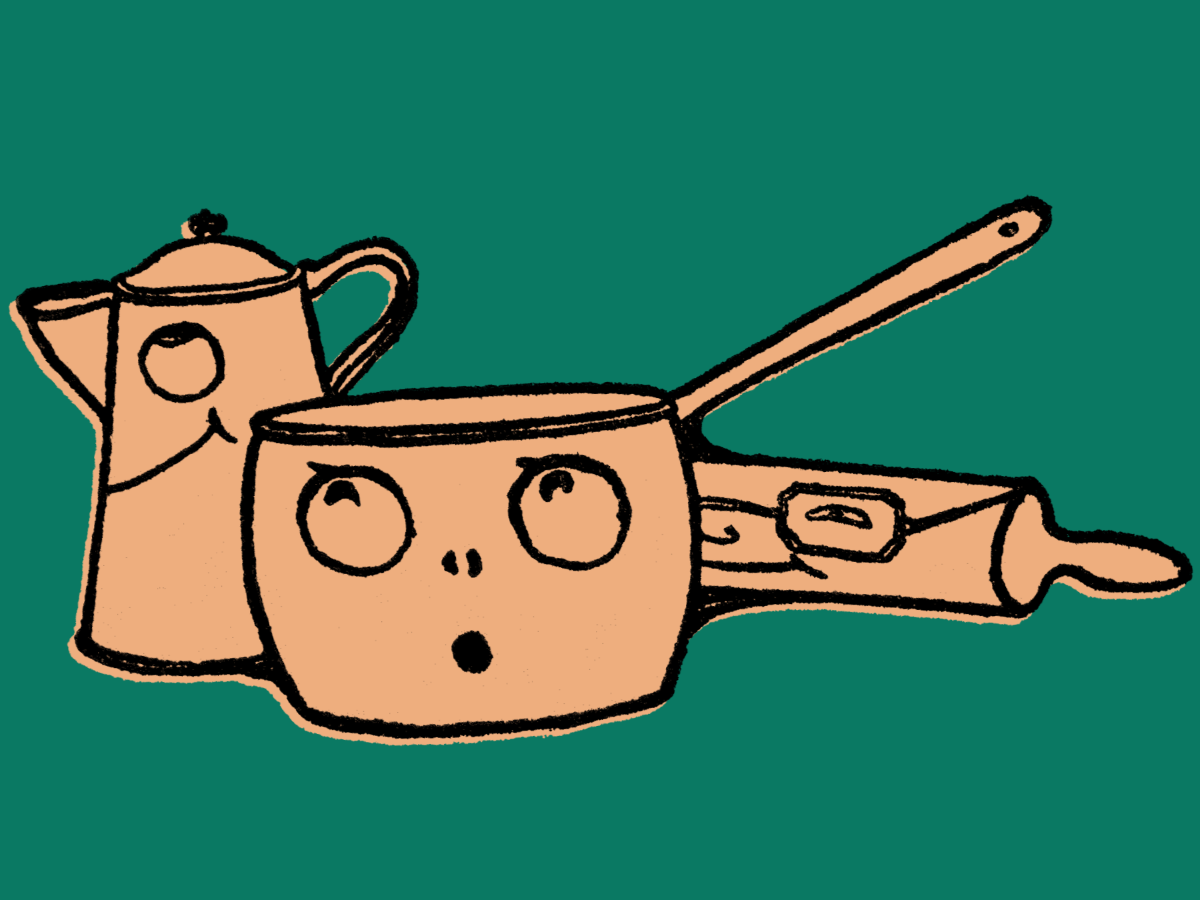The Free Library's newest exhibition from the Special Collections Division, We Are What We Eat, explores the intersection of food, community, and identity.
On view in the Dietrich Gallery on the Third Floor of Parkway Central Library until November 2, 2024, We Are What We Eat examines culinary heritage through historical recipes and cooking techniques passed down through generations. With specially curated items from the Free Library's Rare Book Department, Print and Picture Collection, Map Collection, Children's Literature Research Collection, and Sheet Music Collection, these appetizing artifacts intertwine to tell the many stories of food's role in our lives.
Check out the Free Library's Events Calendar for exhibition-related programs and tours, and explore some of the recipes and resources featured in We Are What We Eat below:
Recipes
Beef Stew'd or Stov'd
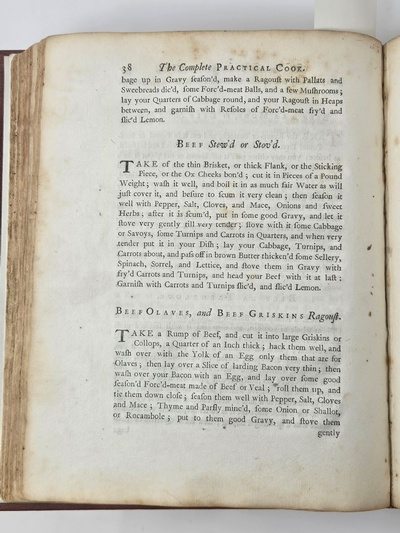
From The Complete Practical Cook (1730)
Take of the thin Brisket, or thick Flank, or the Sticking Piece, or the Ox Cheeks bon’d; cut it in Pieces of a Pound Weight; waſh it well, and boil it in as much fair Water as will juſt cover it, and beſure to ſcum it very clean; then ſeaſon it well with Pepper, Salt, Cloves, and Mace, Onions and ſweet Herbs; after it is ſcum’d, put in ſome good Gravy, and let it ſtove very gently till very tender; ſtove with it ſome Cabbage or Savoys, ſome Turnips and Carrots in Quarters, and when very tender put it in your Diſh; lay your Cabbage, Turnips, and Carrots about, and paſs off in brown Butter thicken’d ſome Sellery, Spinach, Sorrel, and Lettice, and ſtove them in Gravy with fry’d Carrots and Turnips, and head your Beef with it at laſt: Garnish with Carrots and Turnips ſlic’d, and ſlic’d Lemon.
Editor's Note: The ſ character seen in the above recipe is known as the "long s," a now-defunct typographical feature of the English language that disappeared around the mid-1790s. This character was used to denote a lowercase "s" at the beginning or middle of words. Read more about the "long s" on the National Archives blog.
Dandelion Greens
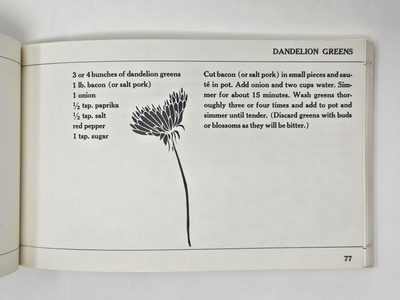
From Soul Food Cook Book (1969)
3 or 4 bunches of dandelion greens
1 pound bacon (or salt pork)
1 onion
½ teaspoon paprika
½ teaspoon salt
red pepper
1 teaspoon sugar
Cut bacon (or salt pork) in small pieces and saute in pot. Add onions and two cups water. Simmer for about 15 minutes. Wash greens thoroughly three or four times and add to pot and simmer until tender. (Discard greens with buds or blossoms as they will be bitter.)
Sure Gingerbread
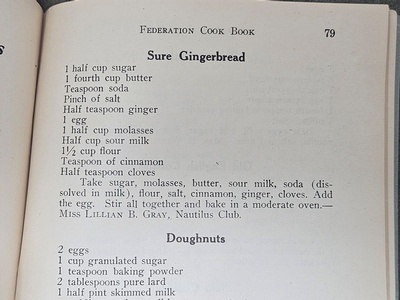
From The Federation Cook Book (1910)
½ cup sugar
¼ cup butter
1 teaspoon soda
pinch of salt
½ teaspoon ginger
1 egg
½ cup molasses
½ cup sour milk
1½ cup flour
1 teaspoon of cinnamon
½ teaspoon cloves
Take sugar, molasses, butter, sour milk, soda (dissolved in milk), flour, salt, cinnamon, ginger, cloves. Add the egg. Stir all together and bake in a moderate oven.
Tomato Jam
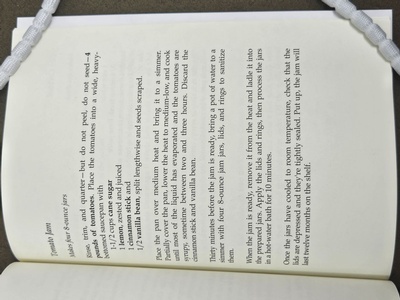
From Menu No. 3 (2022)
Rinse, trim, and quarter — but do not peel, do not seed — 4 pounds of tomatoes. Place the tomatoes into a wide, heavy-bottomed saucepan with:
1½ cups cane sugar
1 lemon, zested and juiced
1 cinnamon stick and
½ vanilla bean, split lengthwise and seeds scraped
Place the pan over medium heat and bring it to a simmer. Partially cover the pan, lower the heat to medium-low, and cook until most of the liquid has evaporated and the tomatoes are syrupy, sometime between two and three hours. Discard the cinnamon stick and vanilla bean.
30 minutes before the jam is ready, bring a pot of water to a simmer with four 8-ounce jam jars, lids, and rings to sanitize them.
When the jam is ready, remove it from the heat and ladle it into the prepared jars. Apply the lids and rings, then process the jars in a hot-water bath for 10 minutes.
Once the jars have cooled to room temperature, check that the lids are depressed and they’re tightly sealed. Put up, the jam will last 12 months on the shelf.
Digital Collection Items
Check out selected items from the exhibition from our Digital Collections:
- "Tortillas" by Herman Ilfeld Bacharach
- Final Art for Pages 28-29 from Lovina: A Story of the Pennsylvania Country by Katherine Milhous
- Book of Hours, Use of Rouen
- Temperance Fountain
- Watch Your Kitchen Waste
- "Horse Mackerel, Freshwater Prawns, and Seaweed" by Utagawa Hiroshige
- Cuneiform Animal Tag
- "Still Life No. 1 [Watermelon]" by Dox Thrash
- Painting of Woman Picking Fruit
Resources
We Are What We Eat: Items from the Exhibition Booklist
Here is a list of the items in the exhibition that are cataloged. Special Collections materials are not always listed in the online catalog like other books. If you have questions about items you may have seen that are not included here, please contact the Special Collection Division.
We Are What We Eat: Learn More
With this catalog list, you can learn more information about and related to objects in the Spring/Summer 2024 Dietrich Gallery exhibition.
While the song "The Candy Pull" is about a party of people making taffy for fun, this video shows you a modern version of the process from a company in Ocean City, NJ:
We Are What We Eat and its related programming is made possible by the work of staff members from the Free Library of Philadelphia across many divisions and departments, particularly Special Collections, the Graphic Design Studio, and Collection Care. Sincere thanks to the Clovernook Center for the Blind and Visually Impaired for providing accessibility features.
Have a question for Free Library staff? Please submit it to our Ask a Librarian page and receive a response within two business days.

